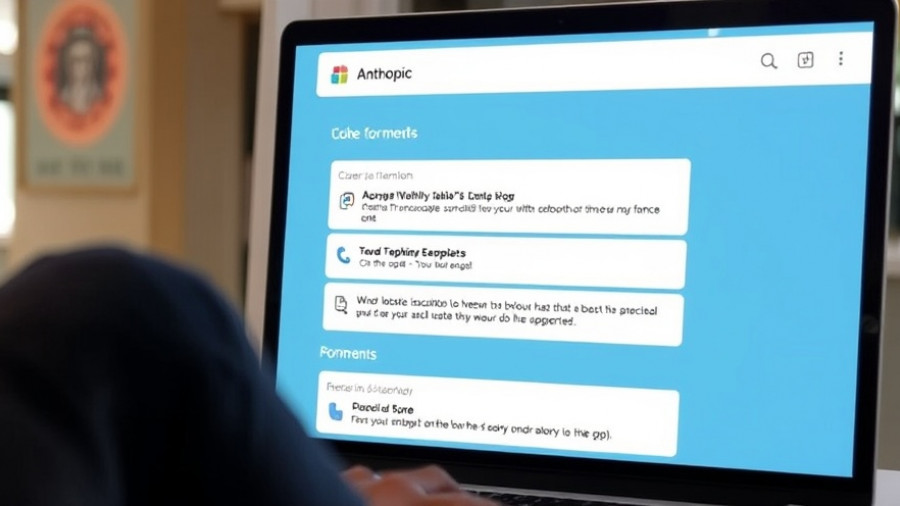
Understanding the AI Landscape: Choosing the Right Tool for Coding
In today's rapidly evolving tech space, developers are faced with an ever-expanding array of artificial intelligence (AI) tools, making the selection process crucial to ensuring project success. From building complex applications to streamlining workflows, tools like ChatGPT-5, CursorCLI, and Claude Code are at the forefront of this revolution. Understanding how these AI assistants stack up against one another not only aids developers in making informed decisions but also highlights the strengths and weaknesses inherent in each option.
Claude Code: Leading the Charge in AI Development
Among the tools evaluated, Claude Code has emerged as the standout performer. Known for its proficiency in executing intricate tasks, Claude Code brings innovative features to the table, such as facilitating AI-generated voice narration and incorporating dynamic background music into projects. Its ability to plan and execute complex workflows with minimal user input is particularly valuable, allowing developers to focus on creativity rather than routine task execution.
This high level of performance emphasizes the tool’s design relevance in a landscape increasingly catered to diversified coding needs. Claude Code's sharp focus on user experience has ensured that it not only meets but also anticipates the challenges developers face today.
ChatGPT-5: A Mixed Bag of Strengths and Weaknesses
While ChatGPT-5 offers notable advantages in its tool-calling and debugging capabilities, it's not without its drawbacks. Users appreciate its quick response times, yet the tool's performance falters with complex programming tasks. For example, during attempts to create a video-generation application alongside CursorCLI, ChatGPT-5 exhibited a lack of adaptability that hampered its efficacy. Such inconsistencies shine light on where the AI still requires further refinement.
Nonetheless, ChatGPT-5 remains an appealing choice for users focused on simpler coding tasks or looking for reliable assistance in debugging. The tool's potential is further enhanced through its ability to integrate with various platforms, suggesting that as updates roll out, it may become increasingly beneficial for a broader range of users.
CursorCLI: Potential Yet to Be Realized
CursorCLI enters the landscape with high expectations, although its current beta phase highlights several complexities that need addressing. Developers report potential, yet execution and planning hiccups underline the necessity for further development before it can compete effectively with more seasoned tools like Claude Code and ChatGPT-5. Given its early-stage status, the performance challenges faced by CursorCLI signal room for growth, reinforcing the idea that AI tools are still maturing.
As advancements continue in this space, it remains to be seen how CursorCLI will evolve and what features it will adopt to bridge the gap with its competitors. Further refinement is critical, as developers experiment with its offerings and provide feedback that could lead to innovative breakthroughs.
Critical Takeaways for Developers
For developers navigating this dynamic AI coding landscape, understanding each tool's strengths and weaknesses is paramount. Claude Code stands out for its ability to tackle complex tasks, while ChatGPT-5 provides valuable support for simpler applications. At the same time, CursorCLI represents emerging innovation, albeit with hurdles to clear. Awareness of these facets can greatly impact the effectiveness of a developer's workflow and the success of a project.
Moreover, developers should tailor their projects to capitalize on the unique strengths of each tool, adjusting prompts and methodologies to achieve optimal results. This adaptability not only positions themselves as forward-thinking professionals but also enhances the productivity and creativity of their coding ventures.
Conclusion: The Future of AI in Coding
As the competition between AI coding tools continues to heat up, the insights drawn from comparing ChatGPT-5, CursorCLI, and Claude Code offer promising guidance for developers. Each tool brings something unique to the table, allowing for more efficient and creative approaches to software development. The evolution of these technologies will invariably shape the future of the coding landscape, making understanding and adaptation crucial for success.
 Add Row
Add Row  Add
Add 




Write A Comment